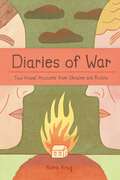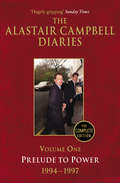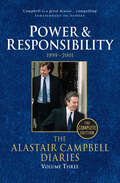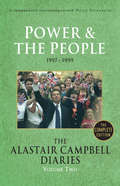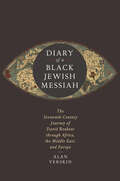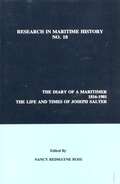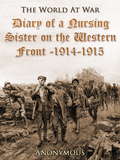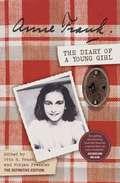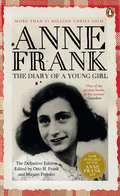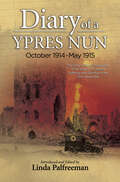- Table View
- List View
The Diaries of Lady Anne Clifford
by D.J.H. CliffordNoblewoman, vividly documents both the great and the trivial events of her long life. They cover her life from her childhood days, when she witnessed the funeral of Queen Elizabeth I, to her last months, when she recalled her past from her room in Brougham Castle. Through compiling and transcribing the manuscript records, D.J.H. Clifford here presents in one volume the full range of Lady Anne's life: her active role at court as the Countess of Dorset (residing at Knole in Kent), her turbulent second marriage to the 4th Earl of Pembroke at Wilton Wiltshire, and her final, long-disputed succession to her father's lands in Westmorland and North Yorkshire. The diaries are complemented by explanatory notes, family trees and illustrations. They provide both an important historical record and an intriguing glimpse into the and character of this noble and Christian lady, whose powerful presence is still in evidence today in the monuments and folklore of Westmorland.
The Diaries of the Maryknoll Sisters in Hong Kong, 1921–1966
by C. ChuThis book is a documentary survey of Hong Kong history, from the 1920s to the mid-1960s, from the perspective of the Maryknoll Sisters, as recorded in their diaries written during that period. It is a priceless collection of first-hand materials on the social history of Hong Kong.
Diaries of War: Two Visual Accounts from Ukraine and Russia
by Nora KrugAn account of two lives during the war in Ukraine: one Ukrainian, one Russian, by the internationally bestselling author of Heimat Diaries of War is a magnificent feat of witness' Alison Bechdel 'Nora Krug's narrative can emotionally drain the reader, but the reader is unlikely to ever forget this book' Andrey Kurkov Immediately following Russia's invasion of Ukraine in February 2022, Nora Krug connected with two anonymous subjects - 'K.', a Ukrainian journalist, and 'D.', a Russian artist - and began what would become a year of correspondence. Deeply moved by the rawness of their responses, she felt that through the personal accounts of these individuals who, directly and indirectly, experienced the war firsthand, she might be able to communicate something of the war and its human impact. Over the course of the next twelve months she communicated with each of them individually via phone chat, condensing their sometimes fluid, sometimes fragmentary answers into a consistent narrative and then created illustrations to go with each entry. The personal accounts contained in this book chronicle the first year of Russia's invasion of Ukraine in an intimate, epistolary format.Diaries of War explores the personal, the political, conflict, family and daily life under war with immense skill, compassion and moving thoughtfulness. Through these two individuals we see the granular effects of war on two lives, but they are emblematic of millions. Diaries of War is a harrowing record of a heart-wrenching historical event that has devastated the world and continues to alter countless lives.
Diaries Volume One: Prelude to Power (The Alastair Campbell Diaries)
by Alastair CampbellAs Alastair Campbell said in the introduction to The Blair Years, it was always his intention to publish the full version, covering his time as spokesman and chief strategist to Tony Blair. Prelude to Power is the first of four volumes, and covers the early days of New Labour, culminating in their victory at the polls in 1997.Volume 1 details the extraordinary tensions between Tony Blair and Gordon Brown as they resolved the question as to which one should stand to become Labour leader. It shows that right from the start, relations at the top were prone to enormous strain, suspicions and accusations of betrayal. Yet it also shows the political and personal bonds that tied them together, and which made them one of the most feared and respected electoral machines anywhere in the world. A story of politics in the raw, Prelude to Power is above all an intimate, detailed portrait of the people who have done so much to shape modern history.
Diaries Volume Three: Power and Responsibility (The Alastair Campbell Diaries #3)
by Alastair CampbellPOWER AND RESPONSIBILITY is the third volume of Alastair Campbell's unique daily account of life at the centre of the Blair government. It begins amid conflict in Kosovo, and ends on September 11, 2001, a day which immediately wrote itself into the history books, changing the course of both the Bush presidency and the Blair premiership. In this volume, we see that New Labour's honeymoon is well and truly over. In addition to detailing the continuing tensions at the top, here we find graphic accounts of a variety of domestic crises: foot-and-mouth disease and protests over fuel prices which almost brought Britain to a halt. Volume Three includes Peter Mandelson's second resignation, the agonies of the Millennium Dome, and the most unexpected slow-handclapping in memory, when the Women's Institute turned against Tony Blair. Yet despite all the problems - not least the most accident-prone manifesto launch in history, complete with deputy prime minister John Prescott punching a voter - Labour won a second successive landslide election victory. That triumph is intimately recorded here, alongside the high points of this period, such as devolution to Northern Ireland and the fall of Milosevic.
Diaries Volume Two: Power and the People (The Alastair Campbell Diaries)
by Alastair CampbellPower & the People covers the first two years of the New Labour government, beginning with their landslide victory at the polls in 1997. This second voume of Campbell's unexpurgated diaries details the initial challenges faced by Labour as they come to power and settle into running the country. It covers an astonishing array of events and personalities, progress and setbacks, crises and scandals, as Blair and his party make the transition from opposition to office.
Diarmuid Lynch: A forgotten Irish patriot (Irish Revolutionary Series #4)
by Eileen McGoughOn Saturday night 22 April 1916, a tense meeting in Dublin went on into the small hours to decide whether or not the Easter Rising would go ahead. Present at that meeting were Pádraig Pearse, Tomás MacDonagh, Joseph Plunkett and Seán MacDiarmada. The fifth man present at the all-night session, Diarmuid Lynch, was the only one still alive a month later. It is difficult to understand how Lynch, a member of the Supreme Council of the IRB, has been forgotten so completely. Lynch was at the heart of plans for the Rising and was aide-de-camp to James Connolly in the GPO. Initially sentenced to death, his sentence was commuted to ten years penal servitude because he was an American citizen. However, he was released on 16 June 1917. Immediately following his release, Lynch became active again, and along with Michael Collins and Thomas Ashe, participated in the reorganisation of the IRB. After the 1917 Sinn Féin Ard Fheis, Lynch, like Collins, held three senior posts: in the IRB, Sinn Féin and in the Irish Volunteers. He was again arrested and deported to America in 1918. Lynch was elected, although still in the US, as a TD for the constituency of Cork South-East in the 1918 elections. In America he was working frenetically as the national secretary of the FOIF (Friends of Irish Freedom) organisation, but later sharp differences arose between De Valera and the FOIF about how funds raised in America should be spent. Lynch did not take part in the Civil War, but made several unsuccessful attempts to stop it.
Diary, 1901-1969
by Kornei ChukovskyA perceptive literary critic, a world-famous writer of witty and playful verses for children, a leading authority on children’s linguistic creativity, and a highly skilled translator, Kornei Chukovsky was a complete man of letters. As benefactor to many writers including Alexander Solzhenitsyn and Joseph Brodsky, he stood for several decades at the center of the Russian literary milieu. It is no exaggeration to claim that Chukovsky knew everyone involved in shaping the course of twentieth-century Russian literature. His voluminous diary, here translated into English for the first time, begins in prerevolutionary Russia and spans nearly the entire Soviet era. It is the candid commentary of a brilliant observer who documents fifty years of Soviet literary activity and the personal predicament of the writer under a totalitarian regime.From descriptions of friendship with such major literary figures as Anna Akhmatova and Isaac Babel to accounts of the struggle with obtuse and hostile censorship, from the heartbreaking story of the death of the daughter who had inspired so many stories to candid political statements, the extraordinary diary of Kornei Chukovsky is a unique account of the twentieth-century Russian experience.
Diary of a Black Jewish Messiah: The Sixteenth-Century Journey of David Reubeni through Africa, the Middle East, and Europe (Stanford Studies in Jewish History and Culture)
by Alan VerskinIn 1524, a man named David Reubeni appeared in Venice, claiming to be the ambassador of a powerful Jewish kingdom deep in the heart of Arabia. In this era of fierce rivalry between great powers, voyages of fantastic discovery, and brutal conquest of new lands, people throughout the Mediterranean saw the signs of an impending apocalypse and envisioned a coming war that would end with a decisive Christian or Islamic victory. With his army of hardy desert warriors from lost Israelite tribes, Reubeni pledged to deliver the Jews to the Holy Land by force and restore their pride and autonomy. He would spend a decade shuttling between European rulers in Italy, Portugal, Spain, and France, seeking weaponry in exchange for the support of his hitherto unknown but mighty Jewish kingdom. Many, however, believed him to favor the relatively tolerant Ottomans over the persecutorial Christian regimes. Reubeni was hailed as a messiah by many wealthy Jews and Iberia's oppressed conversos, but his grand ambitions were halted in Regensburg when the Holy Roman Emperor, Charles V, turned him over to the Inquisition and, in 1538, he was likely burned at the stake. Diary of a Black Jewish Messiah is the first English translation of Reubeni's Hebrew-language diary, detailing his travels and personal travails. Written in a Hebrew drawn from everyday speech, entirely unlike other literary works of the period, Reubeni's diary reveals both the dramatic desperation of Renaissance Jewish communities and the struggles of the diplomat, trickster, and dreamer who wanted to save them.
Diary of a Black Jewish Messiah: The Sixteenth-Century Journey of David Reubeni through Africa, the Middle East, and Europe (Stanford Studies in Jewish History and Culture)
by Alan VerskinIn 1524, a man named David Reubeni appeared in Venice, claiming to be the ambassador of a powerful Jewish kingdom deep in the heart of Arabia. In this era of fierce rivalry between great powers, voyages of fantastic discovery, and brutal conquest of new lands, people throughout the Mediterranean saw the signs of an impending apocalypse and envisioned a coming war that would end with a decisive Christian or Islamic victory. With his army of hardy desert warriors from lost Israelite tribes, Reubeni pledged to deliver the Jews to the Holy Land by force and restore their pride and autonomy. He would spend a decade shuttling between European rulers in Italy, Portugal, Spain, and France, seeking weaponry in exchange for the support of his hitherto unknown but mighty Jewish kingdom. Many, however, believed him to favor the relatively tolerant Ottomans over the persecutorial Christian regimes. Reubeni was hailed as a messiah by many wealthy Jews and Iberia's oppressed conversos, but his grand ambitions were halted in Regensburg when the Holy Roman Emperor, Charles V, turned him over to the Inquisition and, in 1538, he was likely burned at the stake. Diary of a Black Jewish Messiah is the first English translation of Reubeni's Hebrew-language diary, detailing his travels and personal travails. Written in a Hebrew drawn from everyday speech, entirely unlike other literary works of the period, Reubeni's diary reveals both the dramatic desperation of Renaissance Jewish communities and the struggles of the diplomat, trickster, and dreamer who wanted to save them.
The Diary of A.J. Mounteney Jephson: Emin Pasha Relief Expedition, 1887–1889 (Hakluyt Society, Extra Series)
by Dorothy MiddletonThis is a first-hand account of the expedition led by H. M. Stanley in 1887-89 to the relief of Emin Pasha, Governor of Equatoria. A. J. Mounteney Jephson, a typical late Victorian traveller, took part in Stanley’s last expedition in Africa. His recently-discovered diary describes the voyage out of the mouth of the Congo; the journey up the Congo and across the Ituri forests to Lake Albert; the meeting with Emin Pasha; the mutiny of Emin’s troops and their imprisonment of Emin and Jephson; and the journey back to the East coast. Though it fell short of its political and commercial aims, the expedition was important geographically as it solved the last mystery of African topography - the position and nature of the sources of the Nile.
The Diary of A.J. Mounteney Jephson: Emin Pasha Relief Expedition, 1887–1889 (Hakluyt Society, Extra Series)
by Dorothy Middleton Maurice Denham JephsonThis is a first-hand account of the expedition led by H. M. Stanley in 1887-89 to the relief of Emin Pasha, Governor of Equatoria. A. J. Mounteney Jephson, a typical late Victorian traveller, took part in Stanley’s last expedition in Africa. His recently-discovered diary describes the voyage out of the mouth of the Congo; the journey up the Congo and across the Ituri forests to Lake Albert; the meeting with Emin Pasha; the mutiny of Emin’s troops and their imprisonment of Emin and Jephson; and the journey back to the East coast. Though it fell short of its political and commercial aims, the expedition was important geographically as it solved the last mystery of African topography - the position and nature of the sources of the Nile.
The Diary of a Maritimer, 1816-1901: Life and Times of Joseph Salter (Research in Maritime History #10)
by Nancy Redmayne RossThis journal comprises the edited diaries of Canadian seafarer, Joseph Salter, arranged chronologically from 1839 through to 1899, chronicling the many voyages of his career. He took employment with John Leander Starr, a Halifax Merchant, between 1839 and 1841, then moved into ship owning and the purchase of the Moncton, New Brunswick shipyard in 1846. The mid-nineteenth century was a difficult time for shipping, and Salter declared bankruptcy in 1858. He continued to work in maritime industries but gradually moved toward landward business and politics, as shipping went into decline. The diaries provide a comprehensive view of the life of ship-owner, shipbuilder, ship’s agent, and shipbroker during the age of sail. The diaries are introduced by editor Nancy Ross, great-granddaughter of Salter. Chapter 1 serves as Salter’s introduction, Chapters 2 through 16 record his various voyages: to British Guiana; Jamaica; Sierra Leone; Grenada; and his maritime business dealings and later life. Interspersed with his diaries are collections of his letters and several of his renderings of ships and boats. Appendix 1 lists the vessels under his ownerships; Appendix 2 concerns patent applications; Appendix 3 details his genealogy; and Appendix 4 gives a history of the Moncton Shipyard in New Brunswick.
Diary of a Night Bomber Pilot in World War I
by Clive SempleFlying at 18, demobbed at 20, Semple's astonishing experience has been meticulously put into context. How do you fly a Handley Page across France in total darkness? The answer is the 'Lighthouse system', just one of the revelations in this unique record of ingenuity and courage.
Diary of a Nursing Sister on the Western Front, 1914-1915: 1914-1915 (The World At War)
by Anonymous AnonymousExcerpt from book: “Friday, December 18th, 10.30 A.M.--We've had an all-night journey to Rouen, and have almost got there. One of my sitting-ups was 106° this morning, but it was only malaria, first typical one I have met since S.A. A man who saw the King when he was here said, "They wouldn't let him come near the trenches; if a shell had come and hit him I think the Army would 'a gone mad; there'd be no keeping 'em in the trenches after that."
Diary of a Wartime Affair: The True Story of a Surprisingly Modern Romance
by Doreen Bates'Unflinchingly honest... this diary is exceptional' Elizabeth Buchan'Tuesday 23 October, 1934 Another glorious sunny day. Lunch in Kens Gdns. E had not slept well "as I longed and longed for you". It made me happy that he wanted me. I suppose that is mean. He said, "I could pick you out in the dark from fifty women . . ." ' The diary of Doreen Bates is a candid, spellbinding portrait of a gutsy young woman working in London in the years before and during the Second World War, as well as an extraordinary account of her long affair with an older, married colleague - one that brazenly challenged the strict conventions of the day.'Startlingly frank and readable' David Kynaston'Absolutely engrossing' Virginia Nicholson'Astute, passionate, remarkably intimate, showing us the day-to-day picture of a long relationship' Guardian
The Diary of a Young Girl: Anne Frank (Reading age: #12)
by Anne FrankThe Diary of a Young Girl is among the most enduring documents of the 20th century. Anne Frank kept a diary from 1942 to 1944. Initially she wrote it strictly for herself. Then, one day in 1944, a member of the Dutch government in exile announced in a radio broadcast from London that after the war he hoped to collect eyewitness accounts of the suffering of the Dutch people under the German occupation, which could be made available to the public. As an example, he specially mentioned letters and diaries. Anne Frank decided that when the war was over, she would publish a book based on her diary. Anne's diary ends abruptly when she and her family were betrayed. Since its publication in 1947, The Diary of a Young Girl has been read by tens of millions of people. Please note: This title is also available to purchase or loan in hard copy Uncontracted and Contracted Unified English Braille. Please contact the RNIB Helpline on 0303 123 9999 to buy through our Braille on Demand service or loan through our Library.
The Diary of a Young Girl: 12) (PDF)
by Anne FrankThe Diary of a Young Girl is among the most enduring documents of the 20th century. Anne Frank kept a diary from 1942 to 1944. Initially she wrote it strictly for herself. Then, one day in 1944, a member of the Dutch government in exile announced in a radio broadcast from London that after the war he hoped to collect eyewitness accounts of the suffering of the Dutch people under the German occupation, which could be made available to the public. As an example, he specially mentioned letters and diaries. Anne Frank decided that when the war was over, she would publish a book based on her diary. Anne's diary ends abruptly when she and her family were betrayed. Since its publication in 1947, The Diary of a Young Girl has been read by tens of millions of people. Please note: This title is also available to purchase or loan in hard copy Uncontracted and Contracted Unified English Braille. Please contact the RNIB Helpline on 0303 123 9999 to buy through our Braille on Demand service or loan through our Library.
The Diary of a Young Girl: Anne Frank (Reading age: #12)
by Anne FrankThe Diary of a Young Girl is among the most enduring documents of the 20th century. Anne Frank kept a diary from 1942 to 1944. Initially she wrote it strictly for herself. Then, one day in 1944, a member of the Dutch government in exile announced in a radio broadcast from London that after the war he hoped to collect eyewitness accounts of the suffering of the Dutch people under the German occupation, which could be made available to the public. As an example, he specially mentioned letters and diaries. Anne Frank decided that when the war was over, she would publish a book based on her diary. Anne's diary ends abruptly when she and her family were betrayed. Since its publication in 1947, The Diary of a Young Girl has been read by tens of millions of people. Please note: This title is also available to purchase or loan in hard copy Uncontracted and Contracted Unified English Braille. Please contact the RNIB Helpline on 0303 123 9999 to buy through our Braille on Demand service or loan through our Library.
The Diary of a Young Girl: 12) (PDF)
by Anne FrankThe Diary of a Young Girl is among the most enduring documents of the 20th century. Anne Frank kept a diary from 1942 to 1944. Initially she wrote it strictly for herself. Then, one day in 1944, a member of the Dutch government in exile announced in a radio broadcast from London that after the war he hoped to collect eyewitness accounts of the suffering of the Dutch people under the German occupation, which could be made available to the public. As an example, he specially mentioned letters and diaries. Anne Frank decided that when the war was over, she would publish a book based on her diary. Anne's diary ends abruptly when she and her family were betrayed. Since its publication in 1947, The Diary of a Young Girl has been read by tens of millions of people. Please note: This title is also available to purchase or loan in hard copy Uncontracted and Contracted Unified English Braille. Please contact the RNIB Helpline on 0303 123 9999 to buy through our Braille on Demand service or loan through our Library.
The Diary of a Young Girl: The Definitive Edition
by Anne FrankOne of the most famous accounts of living under the Nazi regime of World War II comes from the diary of a thirteen-year-old Jewish girl, Anne Frank. Today, The Diary of a Young Girl has sold over 25 million copies world-wide.It is one of the most celebrated and enduring books of the last century and it remains a deeply admired testament to the indestructible nature of human spirit.Anne Frank and her family fled the horrors of Nazi occupation by hiding in the back of a warehouse in Amsterdam for two years with another family and a German dentist. Aged thirteen when she went into the secret annexe, Anne kept a diary. She movingly revealed how the eight people living under these extraordinary conditions coped with hunger, the daily threat of discovery and death and being cut off from the outside world, as well as petty misunderstandings and the unbearable strain of living like prisoners.The Diary of a Yong Girl is a timeless true story to be rediscovered by each new generation. For young readers and adults it continues to bring to life Anne's extraordinary courage and struggle throughout her ordeal.'One of the greatest books of the century' Guardian'A modern classic' The Times'Rings down the decades as the most moving testament to the persecution of innocence' Daily Mail'Astonishing and excruciating. Its gnaws at us still' New York Times Book ReviewAnne Frank was born on 12 June 1929. She died in Bergen-Belsen, three months short of her sixteenth birthday.
Diary of a Ypres Nun: October 1914-May 1915
by Linda PalfreemanThe Diary of Soeur Marguerite of the Sisters of Lamotte Suffering and Sacrifice in the First World War. The campaign in Flanders, with its successive battles, would be the longest of the Great War and the costliest in terms of human life. At the centre of the fearful and prolonged barrages of shelling by the military of both sides lay the town of Ypres, known for its Cloth Hall and cathedral, its butter and its lace -- now to be blasted to infamy as an indelible symbol of suffering and sacrifice and wanton destruction. The underground passageways of the towns ancient fortifications provided shelter for the trapped townspeople. In desperate circumstances courageous and selfless individuals administered medical attention, distributed food and clothing, provided milk for babies and set up orphanages and schools for children. Some of these volunteers, such as the Friends' Ambulance Unit (FAU), came from afar, whilst others already formed an essential part of the moral and social fibre of the beleaguered town: these included the local priest, Camille Delaere, and the nuns who lent him their support. The cures indefatigable assistant was the young nun Soeur Marguerite of the Sisters of Lamotte, and it is her daily journal that became The Diary of an Ypres Nun. Originally published in French in 1917, this harrowing yet sometimes surprisingly humorous account of events in the besieged and battered town of Ypres was written between October 1914 and May 1915, as she worked alongside the FAU and Father Delaere, to bring comfort and succour to the suffering civilian population.
The Diary of an Ambassador Vol. I: Versailles to Rapallo 1920-1922 (The Diary of an Ambassador #1)
by Edgar D’AbernonOriginally published in 1929, in this first volume in a series of three, The Right Honourable Viscount D’Abernon aims to illustrate “the early phases through which negotiations passed between the Great Powers and Germany in the years before the Treaty of Locarno was signed and before Germany entered the League of Nations. The pages are principally concerned with the subjects of reparation, German disarmament, and with the German financial crisis. Professor Gerothwohl has undertaken the task of annotating the Diary, and of supplying the links necessary to a comprehension of the historical sequence of events. A more competent guide could not be desired, his grasp of the European situation at the period being probably unrivalled. It has been thought expedient to limit explanation to the bare minimum required for clarity, and to allow the Diary to speak as far as possible for itself.“How far the reader will find that the present volume fulfils its purpose and furnishes the necessary knowledge for a comprehension of the period is not for me to say, but it may be hoped that a clear idea will be gained of the essential object before English statesmanship, namely, the restoration of peace to Europe.”—1st Viscount D’Abernon, Introductory SurveyA fascinating read and invaluable addition to the British Historian’s book collection.
The Diary of an Ambassador Vol. II: Rapallo to Dawes 1922-1924 (The Diary of an Ambassador #2)
by Edgar D’AbernonOriginally published in 1930, this second volume in a series of three portrays the history of 1922 and 1923. In this volume, 1st Viscount D’Abernon centres on the occupation of the Ruhr by French troops; the events immediately preceding that occupation and leading up to it; the consequences of that occupation; and the results, “good and bad,” which proceeded from it—”notably the dramatic collapse of German finance.”“The essential fact to be borne in mind in the study of 1923 is that this year witnessed the culminating point of the conflict between the policy of force and the policy of pacification.“The first volume of these memoirs was concerned mainly with debate and discussion. In Volume II deeds replace words, drastic action is not merely threatened but ruthlessly enforced. The menace of overpowering catastrophe darkens the horizon and imparts tragic significance to events. It was a time of decisive importance in the history of Europe: the years of war were hardly more charged with fate. In 1923 the condition was indeed one of virtual warfare. On the side of France, a resolute will, a clear policy, and overpowering military strength. On the side of Germany, a courage born of despair, a certain sense of injustice, and a hope that the world would not endorse action which many deemed spoliation.”—1st Viscount D’Abernon, Introductory SurveyA fascinating read and invaluable addition to the British Historian’s book collection.
The Diary of an Ambassador Vol. III: Dawes to Locarno 1924-1926 (The Diary of an Ambassador #3)
by Edgar D’AbernonOriginally published in 1931, this third volume in a series of three portrays the history of 1924 to 1926. In this final volume, 1st Viscount D’Abernon examines three major events: the Dawes settlement in 1924, the Locarno Agreement in 1925, and the entry of Germany into the League of Nations in 1926. Of these three events, D’Abernon holds that the greatest was Locarno.“Dawes laid the foundation—Geneva crowned the edifice, but the essential building was carried through in October 1925, in that now historic village on the Italian lakes. Imagination has been stirred by Locarno—Locarno is the central theme of the present volume.”—1st Viscount D’Abernon, General SurveyA fascinating read and invaluable addition to the British Historian’s book collection.


